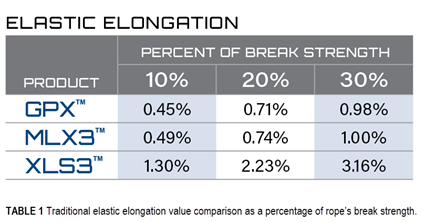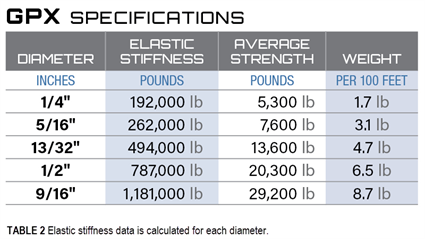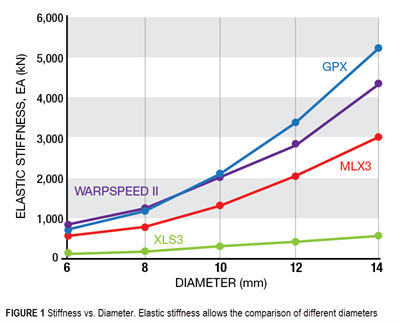A Better Measure for Selecting Ropes
Overview
Selecting a line when rigging a sailboat requires an understanding of how the available ropes perform. While there are many properties to consider, often one of the most important—elastic stiffness, a rope’s resistance to elongation—is
the least understood.
In a sailboat’s rigging, some lines benefit from lower stretch to limit movement while others require a higher degree of elasticity to ease strain on hardware and fittings. The lines on a sailboat responsible for controlling the shape of the sails,
for example, are subject to varying loads as wind direction and loads change. Ropes with lower stretch will limit the extension over this expected load range and allow trim to be consistently maintained. Line applications such as preventers, vangs,
and mooring lines benefit from greater stretch when loads increase to allow the sail shape to “dump” additional loads and ease strain on deck fittings.
Changing the way we express elongation
A rope’s axial stiffness is a representation of the amount the rope stretches as it experiences varied load. In fiber ropes, this is a fairly complex behavior that includes elastic elongation, constructional elongation, hysteresis, extension while
working, and extension when relaxed. Elongation has traditionally been shown as a percentage of change in length at predefined loads (10%, 20%, 30% of the rope’s breaking strength). See Table 1.

Samson engineers have analyzed test data on a wide range of constructions and fibers to develop a simple, more reliable method for comparing elastic stiffness across a range of sizes, materials,and product designs.
Samson now publishes a new data point—elastic stiffness (EA)—in its specification charts when describing ropes developed for sailing applications. Elastic stiffness is defined as the resistance of a line to stretch under load and is referred
to as EA, based on E × A, where E is the material’s elastic modulus or Young’s modulus (the intrinsic stiffness of the material), and A is the cross-sectional area of the material. It incorporates strength, diameter, material, and
construction of the line—the characteristics of most concern to the sailor. See Table 2. These stiffness values are available for each diameter of recreational marine running rigging products, along with break strength and weight.

As a rule of thumb, the higher the elastic stiffness (EA), the stiffer the rope. This allows the sailor to compare the elastic stiffness of two different diameters of the same line or two different lines directly and, using a simple calculation, determine
the change in length that the rope will exhibit under a given load. See Fig. 1.
The Effect on Running Rigging Line Selection
For lines that require less elongation—halyards, jib/genoa sheets, cunninghams, and outhauls—Samson recommends that sailors look for higher stiffness values. When comparing lines for these applications, choose the diameter with the required
strength, weight, and stiffness for the application. Higher-performance ropes may allow the same strength and a higher stiffness at a smaller diameter, creating less weight aloft (in halyards).
For lines where a little “give,” or stretch, is beneficial—boom vangs, preventers, and mooring lines—sailors should look for lower stiffness values, always keeping in mind the diameters and strength requirements for the application.
Using the New Elastic Stiffness (EA) Values: A Comparison with the Legacy EE Values 
Both the legacy elastic elongation (EE) values and the new stiffness (EA) values represent the amount of elastic elongation (stretch) that a rope will experience when subjected to a load. The difference between them is that the EE values are for a
rope construction/fiber combination in general at only three different loads (percentage of break strength), while the EA values are available for each size of each rope construction. When comparing the elongation characteristics of two different
rope constructions and fiber blends, either value will work.
In practical application, the difference is also seen in how the values are used. To calculate the actual change in length a rope will experience in use and under load, the new EA values provide a much simpler calculation. Looking at a specific example,
we will determine how much change in length we can expect in a halyard when the load on it varies due to fluctuating wind speed. See sample calculations for both methods in the sidebar at the right.
Conclusion
Elastic stiffness can be used for directly comparing how different ropes will perform in sailing applications and provides a relatively simple means of determining how much stretch to expect from a rope under varying loads.
